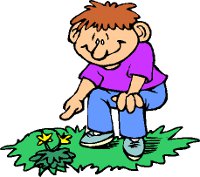Creative Wildflower Garden Ideas
April showers might bring May flowers but a good ground soaking March can do wonders as well. Have you ever driven along the highways of the Texas hill country in April and beheld the beauty of the bluebonnets and Indian paint brush in full bloom? When March has brought adequate amounts of rain, the hills seem to be carpeted in a beautiful tweed look of green, blue and dark red.
| Wildflowers such as these can cause a hardworking gardener to consider if it is worth the effort to continue dealing with a high-maintenance mixed border and instead sow a can of wildflower seeds and let nature take its course. Unfortunately, it doesn't work quite like that.
What is a wildflower? These are typical species which show themselves to be self-reproducing and hardy, needing little attention from a gardener and tend to prefer poor soil. (Just the ticket for an overworked gardener, huh?) Well, as the old saying goes, if it sounds too good to be true, it well may be. In this case, it very well could be and then again; maybe not!
|
 |
If you really have your heart set for your garden or
landscaping ideas
to have a more natural look with wildflowers, these steps should help you achieve your goal.
If you want your plants to be self-sustaining, then play by their rules and you will have better luck.
Begin by choosing a site with
full or partial sun.
Full sun consists of 6+ hours of direct sunlight daily.
Partial sun is 3-6 hours per day, usually morning and afternoon.
 |
Weed control is extremely important, but how do you tell a wildflower from a weed?
Unless you majored in
landscaping or wildflower botany, the easiest way is to start with a clean slate.
Remove all forms of vegetation from the area where you want your garden to grow. Till the soil to a depth of three inches after the vegetation is removed and then rake and level the soil.
Leave grooves from the raking to hold the seeds.
|
| As you plant your garden, you will notice most wildflower seeds are very small. If you mix a little sand with the seed, you will have an easier time spreading the seeds evenly. Broadcast the seeds evenly in the prepared area, then rake lightly after the seeds are spread.
Water your entire garden area, keeping the seeds moist until the plants are a few inches tall.
Mulch lightly with straw, peat or compost to retain moisture and discourage birds from munching away the garden.
|
 |
The first year of your garden, the perennial
wildflowers probably won't bloom. However, remember your goal is to
enjoy this garden for years to come. As time goes on, an occasional
over-seeding helps to maintain plant balance. Do this every couple of
years or whenever unfavorable weather conditions have been a problem and
cause an imbalance.
As wild flowers attract
butterflies and bees you may like to check out this
Ultimate Guide to Butterflies and how to prevent their decline.
Copyright © 2000-2020
Hints and Things
All Rights Reserved.
No portion of this site may be reproduced or redistributed without prior
written permission from Hints and Things. All trademarks &
copyrights throughout Hints and Things remain the property of their
respective owners.
Hints and Things cannot be
held responsible for any information given on this site nor do they
necessarily agree with, or endorse, the views given by third parties.
|

